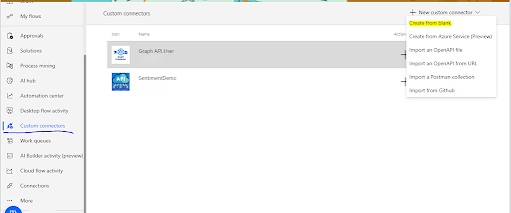Calling Microsoft Graph API from Power Automate Using Azure App Services – Step-by-Step Guide
Step 1: You should have an Azure subscription, or if you have access to the Microsoft Entra Admin Center, you can create an app from there. This app can then be used in Power Automate to connect to Microsoft Graph API.
Step 2: Click on "New registration", provide a name for your app, assign the required API permissions (such as Microsoft Graph permissions), and then click "Register" to complete the app registration process.Step 3: After registration, you'll be redirected to the app's overview page. From there, navigate to the API permissions tab and click "Add a permission" to assign the necessary Microsoft Graph API permissions.
Step 4: Select Microsoft Graph as the API, and based on your requirements, choose the appropriate permissions. In my case, I selected Application permissions, which do not require user sign-in and are suitable for background services or automation.
Step 5: Select the required Microsoft Graph API permissions. You can refer to the Microsoft Graph API documentation to determine which permissions are needed for different Graph API endpoints. Add the permissions that align with your use case.To retrieve a user's ID using Microsoft Graph, your app must have the User.Read permission (or another appropriate permission like User.Read.All, depending on the scope).
Step 6: Once you’ve added the necessary permissions, click on "Grant admin consent" to authorize them for your organization. This step is required for application permissions and some delegated permissions.
Yes, that's it! We have successfully set up our first Microsoft Graph API app on Azure.
Now, go to Power Automate, create an Instant Flow, and add an HTTP action as shown in the image below.
Step 8: You need to specify the Authentication Type. Please provide the details as shown below.
Authentication Type: Azure Active Directory
Tenant: Provide your Tenant ID
Audience: Use the Microsoft Graph API link (https://graph.microsoft.com)
Client ID: Provide your Client ID
Credential Type: Secret
Secret: Provide your Secret ID

Step 9: Generate a Client Secret as shown in the image below.
Copy the details shown in the Value column and paste them into the Secret ID field.
That’s it! You have successfully created your first application using Azure App Service and Power Automate.












Comments
Post a Comment